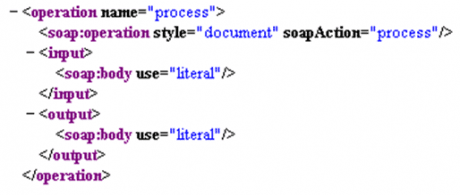- Acknowledgement Modes in TIBCO EMS
- EDI Integration in TIBCO BW
- How to Monitor TIBCO EMS using TIBCO HAWK
- Start a Business Process from a Page flow in TIBCO AMX BPM
- TIBCO ADB Adapter Interview Questions
- TIBCO BE Interview Questions for Beginners
- Tibco BW Interview Questions
- TIBCO EMS Interview Questions
- TIBCO Hawk Interview Questions
- Configure HAWK Rulebase To Monitor Long Running Process
- Tibco Hawk Deployment Checklist and Rulebase Monitoring
- Hawk Rulebase to Monitor EMS Queues - TIBCO BW
- TIBCO Hawk Rulebase for Monitoring Virtual Memory
- How To Configure BW Microagent For TIBCO HAWK Display
- Configure TIBCO HAWK Plugin For EMS On Windows
- Configure TIBCO Hawk Security Trusted Model
- The HAWK Rulebase To Monitor Connection Pool
- How To Monitor Exceptions And Notification In TIBCO HAWK
- How To Monitor Middleware Components Using HAWK Rulebase
- Monitor SLAs using TIBCO Hawk Rulebase
- How To Reprocess Failed Transactions In TIBCO BW
- TIBCO HAWK Rulebase To Monitor Threads
- Monitoring Load Balancing & Fault Tolerance in BW with Hawk - TIBCO
- Configuring TIBCO Hawk for EMS
- Tibco EMS Delivery Modes
- What is UDDI in Web Services
- Web Services Communication Flow - TIBCO
- Brief Introduction to TIBCO Web Services
- JasperReports Tutorial (2024) - A Complete Guide
- Tibco BW Tutorial
WSDL Enters
A WSDL document is just a simple XML document.
It contains set of definitions to describe a web service.
WSDL document fulfills all the above requirements
- Requirement 1 – Where is the service hosted
- Requirement 2 – What protocol to use to talk to the service
- Requirement 3 – What are the operations
- Requirement 4 – What are the parameters
- Requirement 5 – What is the data type of the messages
| Table of Content - What is WSDL in Web Services |
Introducing WSDL
- WSDL stands for Web Services Description Language
- WSDL is written in XML
- WSDL is used to describe Web services
- WSDL is also used to locate Web services
- WSDL is a W3C recommendation
WSDL Document Structure
WSDL Ports
- The element is the most important WSDL element.
- It describes a web service, the operations that can be performed, and the messages that are involved.
- The element can be compared to a function library (or a module, or a class) in a traditional programming language
Operation Types
Type Definition
One-way The operation can receive a message but will not return a response
Request-response The operation can receive a request and will return a response
Solicit-response The operation can send a request and will wait for a response
Notification The operation can send a message but will not wait for a response
One-way operation type
The operation can receive a message but will not return a response
.png&w=16&q=75)
Request-response operation type
The operation can receive a request and will return a response

Now, a web service operation can take only one parameter. But I want to pass multiple parameters……what do I need to do
WSDL Messages
- The element defines the data elements of an operation.
- Each message can consist of one or more parts. The parts can be compared to the parameters of a function call in a traditional programming language.
I want to pass a complex object to my web service……what do I need to do
WSDL Types
- The element defines the data type that are used by the web service.
- For maximum platform neutrality, WSDL uses XML Schema syntax to define data types.
I want my web service to be accessible to a HTTP client, as well as to a RMI client and a SOAP client……what do I need to do
WSDL Bindings
The element defines the message format and protocol details for each port.
Binding
- name – can be anything
- Type – points to port
Soap:binding
- Style – rpc or document
- Transport – soap protocol to use
Operation
- Defines each operation the the service exposes
WSDL Bindings
- The element provides specific details on how a portType operation will actually be transmitted over the wire.
- The bindings can be made available via multiple transports, including HTTP GET, HTTP POST, or SOAP.
- The bindings provide concrete information on what protocol is being used to transfer portType operations.
- For SOAP protocol, the binding is , and the transport is SOAP messages on top of HTTP protocol.
- WSDL 1.1 includes built-in extensions for SOAP 1.1. This enables you to specify SOAPspecific details, including SOAP headers, SOAP encoding styles, and the SOAPAction HTTP header. The SOAP extension elements include:
- soap:binding
- soap:operation
- soap:body
- You can specify multiple bindings for a single portType.
WSDL Services
The element connects the binding to an actual URL where the service is available.
A service element describes a Web service as a collection of port elements. A port element defines a specific network address for a binding. The sample below shows the basic outline of a service that supplies an address for a SOAP binding:
The ServiceName sets the name of the service. The PortName sets the name of the specific address. The BindingRef refers to the name of a binding element. The BindingRef must be namespace qualified if the targetNamespace for the WSDL definitions element is not the same as the default namespace.
Example
![]()
 On-Job Support Service
On-Job Support Service
Online Work Support for your on-job roles.

Our work-support plans provide precise options as per your project tasks. Whether you are a newbie or an experienced professional seeking assistance in completing project tasks, we are here with the following plans to meet your custom needs:
- Pay Per Hour
- Pay Per Week
- Monthly
| Name | Dates | |
|---|---|---|
| TIBCO BusinessWorks 6.x Training | Jan 13 to Jan 28 | View Details |
| TIBCO BusinessWorks 6.x Training | Jan 17 to Feb 01 | View Details |
| TIBCO BusinessWorks 6.x Training | Jan 20 to Feb 04 | View Details |
| TIBCO BusinessWorks 6.x Training | Jan 24 to Feb 08 | View Details |

Ravindra Savaram is a Technical Lead at Mindmajix.com. His passion lies in writing articles on the most popular IT platforms including Machine learning, DevOps, Data Science, Artificial Intelligence, RPA, Deep Learning, and so on. You can stay up to date on all these technologies by following him on LinkedIn and Twitter.
















